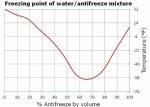enginesilo
Petty Officer 1st Class
- Joined
- Jun 9, 2008
- Messages
- 355
Hi all, wanted to get some insight if I winterized and got anti-freeze into my outdrive water pickup tube and the exhaust manifolds properly. Hoping someone can shed some light that uses anti-freeze. I know many say air doesn't freeze, but I've used Anti-freeze for a long time and its never done me wrong. So this is a thread about using anti-freeze, not just draining.
My engine is a 5.0 GXI with a duo-prop outdrive, this is my first year with this engine.
I went ahead and drained the manifolds, drained the engine block, and I also removed the tube off the circulation pump, and both of the tubes on the water/impeller pump until there was no more water coming out. After it was all drained, I proceeded to fill with anti-freeze from all the tubes that come off the Thermostat (1 tube to each exhaust manifold, 1 tube to the circulation pump, and 1 tube to water pump if I remember correctly). All that went as it normally does and I filled until the passages were full until the tubes were about to overflow. What I'm unsure of is 2 things:
-When I filled the 1 tube on the water impeller pump that is the pickup tube, it never drained anti-freeze out the outdrive. On my old boat I could hear the anti-freeze pour out as the plumbing went directly out the outdrive. Should this happen with this motor and outdrive setup? Should 1 of the 2 tubes on the water impeller pump drain directly out of the outdrive when anti-freeze is poured into it?
-When filling the manifolds from the 2 smaller tubes off the thermostat housing, should the tube fill up at the thermostat side and no longer take anti-freeze, or should it fill enough to come out the exhaust and out the back of the boat at the outdrive where the water normally exits? Not sure if the anti-freeze would make it over the riser angle, but I wasn't sure. Is it normal to just fill up, and then work its way to the thermostat side of the tube? Or should it make its way out the exhaust system and out the back of the boat?
Seems like it all went to plan other than these 2 cases where this could be the norm, or I need to do something differently.
Thanks
My engine is a 5.0 GXI with a duo-prop outdrive, this is my first year with this engine.
I went ahead and drained the manifolds, drained the engine block, and I also removed the tube off the circulation pump, and both of the tubes on the water/impeller pump until there was no more water coming out. After it was all drained, I proceeded to fill with anti-freeze from all the tubes that come off the Thermostat (1 tube to each exhaust manifold, 1 tube to the circulation pump, and 1 tube to water pump if I remember correctly). All that went as it normally does and I filled until the passages were full until the tubes were about to overflow. What I'm unsure of is 2 things:
-When I filled the 1 tube on the water impeller pump that is the pickup tube, it never drained anti-freeze out the outdrive. On my old boat I could hear the anti-freeze pour out as the plumbing went directly out the outdrive. Should this happen with this motor and outdrive setup? Should 1 of the 2 tubes on the water impeller pump drain directly out of the outdrive when anti-freeze is poured into it?
-When filling the manifolds from the 2 smaller tubes off the thermostat housing, should the tube fill up at the thermostat side and no longer take anti-freeze, or should it fill enough to come out the exhaust and out the back of the boat at the outdrive where the water normally exits? Not sure if the anti-freeze would make it over the riser angle, but I wasn't sure. Is it normal to just fill up, and then work its way to the thermostat side of the tube? Or should it make its way out the exhaust system and out the back of the boat?
Seems like it all went to plan other than these 2 cases where this could be the norm, or I need to do something differently.
Thanks




















